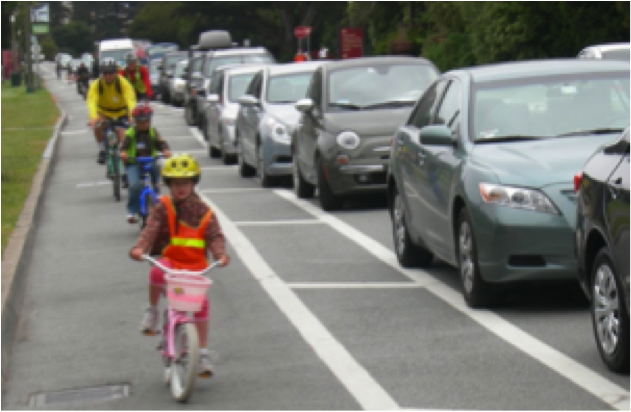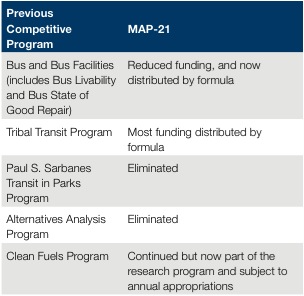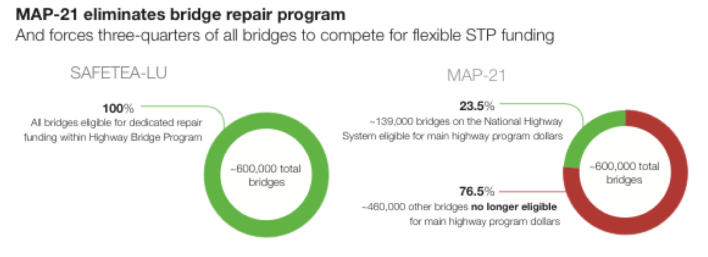OK, truth: Raise your hand if you find federal transportation legislation intimidating and incomprehensible.

I thought so. Me too.
The problem, as you know, is that it’s enormously important that advocates not only understand the new transportation law, MAP-21, but that they understand it in granular detail so they can find the small opportunities buried in a depressingly large mass of disappointment.
So a big thank-you goes out to the folks at Transportation for America, who just released exactly the resource advocates need: a guide to the law called “Making the Most of MAP-21.”
In addition to providing a basic outline of the law and its relevant provisions (and omissions), the document contains some excellent how-to’s and talking points for advocates and project sponsors trying to squeeze funding for sustainable transportation projects out of programs biased heavily toward auto-oriented infrastructure.
Here are a few of the excellent ideas that stand out:
Ask states to flex highway funds for bridge repair. One major hidden peril of MAP-21 is that it transferred the responsibility of repairing 460,000 bridges that aren’t on the National Highway System (NHS) to the overburdened Surface Transportation Program (STP), without adding any money for it. In fact, STP has $5 billion of new responsibilities under MAP-21 and only $1 billion of new money.
Luckily, there’s a solution: States can flex up to half of their National Highway Performance Program (NHPP) funds, normally earmarked for NHS projects, to other uses. After all, NHS gets a disproportionate share of funding: “Although the NHS represents only five percent of all American roads, fully 58 percent of the highway program is committed to its upkeep,” the report says.
T4A even suggests talking points for dealing with reluctant state officials. For example, if you hear that using NHPP money for non-NHS projects “would undermine our investment strategy,” you can say that “for the past 20 years these bridges were fixed with money that is now in this program, so transferring funds out of the NHPP to fix them would not result in a change from current practice.” Shazam!
Use safety money for bike/ped. Given the enormous financial pressure states are under, they’ll be tempted to “flex” bike/ped money toward other uses, too. Don’t let them. The amount they’ll get by gutting the Transportation Alternatives fund is negligible, but it would be devastating for active transportation.
Another clever way to maximize funding for street safety projects is to use funds from the Highway Safety Improvement Program (HSIP). “Although states typically spend little or no HSIP money to protect people on foot or bicycle, there is a strong argument for doing so because 15 percent of all traffic fatalities nationally are bicyclists and pedestrians,” the report says.
Again, there are talking points for this. If they say, “Bicycle and pedestrian projects cost too much compared to the benefits they yield,” you can shoot back with this: “That depends on how you define benefits. Projects that reduce injuries and deaths save millions in emergency medical costs, provide more people the opportunity to walk and bicycle, improve exercise rates and health, reduce health care costs, and improve quality of life. Why shouldn’t these factors be part of the cost-benefit assessment?” Shazam!
States are also now required to include bike/ped safety in their Strategic Highway Safety Plans -- another opportunity for advocates to include favorable language.
Utilize CMAQ money for transit improvements. The traditional federal program for transit, New Starts, is only for added capacity, not for the cost of operating buses and trains. Meanwhile, transit systems all over the country are struggling to avoid service cuts and fare hikes given the current budget crisis.
But areas with air pollution problems can use funds from the Congestion Mitigation and Air Quality (CMAQ) program for operations and state of good repair.
And regions with a population over a million are required to develop a CMAQ performance plan with targets for reductions in congestion and air pollution. “If you live in one of these places it will be important to engage during the development of this plan as it can either help steer funding towards new transit service or away from it,” the report advises.

Use highway funds for transit. If states flex NHPP dollars to bridge repair, as mentioned above, that could free up some STP money for transit. But better yet, flex some of those NHPP dollars directly to transit. After all, states can flex up to half of their NHPP dollars to transit too. Unfortunately, they need to meet a series of conditions. “To use these funds, the new transit line must (i) be adjacent to a freeway or Interstate, (ii) reduce delay on the adjacent highway, and (iii) be more cost-effective than an improvement to the highway,” the report says. “These are significant hurdles to clear, but given that this is the largest formula program, it is worth considering as an option where possible.”
Take advantage of other funding. Projects of National and Regional Significance (PNRS) is a sort of anemic version of the discretionary Transportation Investments Generating Economic Recovery program (TIGER), which Congress failed to include in the authorization. It’s for big projects that are also eligible for formula funding and doesn’t have the innovative focus TIGER does. Nevertheless, it’s an option to be exploited, especially for large projects like high-speed rail, which got exactly diddly-squat in the authorization.
MAP-21 did authorize a small new pilot program for transit-oriented development -- just $10 million -- for communities to improve station-area planning and bike/ped access to transit stations. That can include making changes to local zoning and development codes.
As always, the Urbanized Area Formula Grants make up more than 40 percent of available transit funds, and can be used under different conditions for capital projects, maintenance, and operations.
Scavenge. State DOTs often allocate money years in advance, especially for multi-year projects and those with ongoing maintenance needs. But with big bites taken out, there may still be some crumbs left -- too small for major road work, but enough for a bike lane or a few more bus drivers.
Start early. Go to those public comment sessions. Participate in citizen review meetings. Check the DOT or MPO website for plans. If you were used to waiting until the environmental review process for input, you might be too late: changes in MAP-21 accelerated that process such that your chance to weigh in could slip away before you know it.
T4A emphasizes also the importance of participation in the development of state freight plans. MAP-21 beefed up the national freight program, providing opportunities for advocates to help shape policy at all levels. Community activists concerned about the environmental impacts of freight movement will be especially interested in weighing in during these discussions.
Challenge authority. The talking points T4A lays out provide a sound, if sometimes confrontational, counter-argument to the status quo. T4A encourages advocates to challenge traffic projections, which are often based on old forecasts and not new trends that show less driving, more transit, and smarter growth.
The appendices include state-by-state data, so that advocates can be precise when telling state officials just how many pedestrians died on their state’s roads last year, or how much money they have available for active transportation.
The document Transportation for America produced is an excellent primer for those just looking to understand the law better. It’s also a cheat sheet for reformists’ demands in the next round. Under the banner “Missed Opportunities,” T4A outlines the crucial reforms MAP-21 failed to enact. It's a long list: a truly transformative bill would have identified a real solution to the funding shortfall to dedicating repair funding, strengthened performance measures to ensure that spending aligns with national goals, included Complete Streets provisions, and brought commuter benefits for transit riders up to the level enjoyed by drivers -- for starters.
There are so many chances to produce a better bill in 2014, and advocates -- and lawmakers -- are already starting to imagine it. But in the meantime, the T4A document is a handy guide to making the most of the MAP-21 era.






